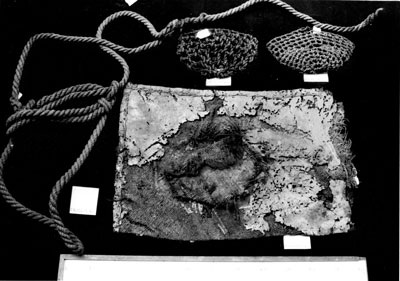
 |
 |
 |
 |
 |
 |
 |
 |
 |
 |
 |
 |
Goods
 |
|
Utilitarian
items from Karanis |
Utilitarian Items
Cloth was used for more than clothing and furnishings. Cloth also served such practical purposes as securing large items, carrying cumbersome loads, and padding rough surfaces. The tough, durable fabrics needed for such tasks were often made of thick threads of animal hair and rough plant (bast) fibers rather than finely spun wool or linen (also a type of bast fiber). Typically, the weave structure of these fabrics is fairly basic--easily executed and easily mended. These items, it seems, were often made and repaired in the home, as were nets, ropes, and baskets. (The archival photograph illustrates examples of such items found at Karanis, including the leather-covered hair pad in the exhibition.) Not all utilitarian items were home made. Some--apparently those made by specialists--were purchased. There are, in fact, ancient documents from Karanis that mention shopping for utilitarian items (including mattresses, pillows, and towels).
Variety, Condition, and Usage
There are many different types of cloth artifacts from Karanis. They served as towels, cushions and mattresses, curtains and wall-hangings, and tunics, caps, cloaks and socks. The cloth artifacts display varying levels of skill and artistry, ranging from sophisticated to crude in execution and from refined to rudimentary in weaving technique. There are remains of tough leather-covered pads made of plain-woven coarse animal hair, as well as light-weight garments of finely spun linen and multicolored wool threads intricately woven to display complicated decorative compositions. The figural composition on display is one of very few such compositions from among all the textiles found at Karanis: most decorations are abstract.
Between these opposite ends
of the spectrum are numerous examples of competently woven fabrics with
minimal decoration. Nearly all, however, bear traces of a great deal of
use. Edges are frayed. Holes and stains obscure shapes and patterns. Darns,
patches and other mends attempt to repair damage and make items whole
again. Some items are constructed entirely of rags. Due to the labor-intensive
character of cloth production, the need for specialized skills and tools
for weaving, cloth was much more valuable in antiquity than it is today
and consequently was repaired and reused much more frequently than it
is now.